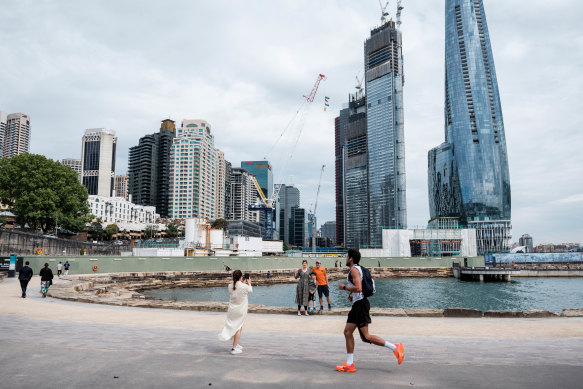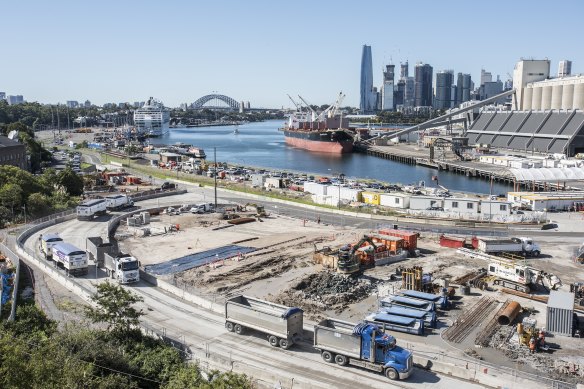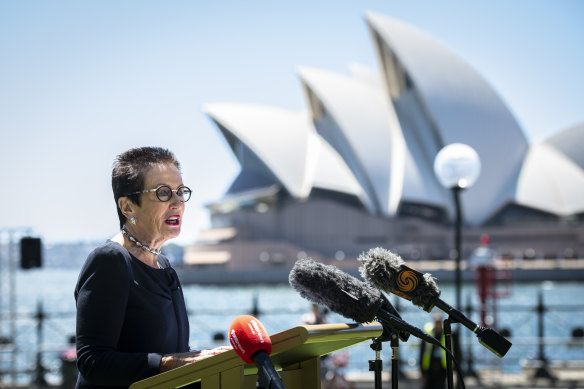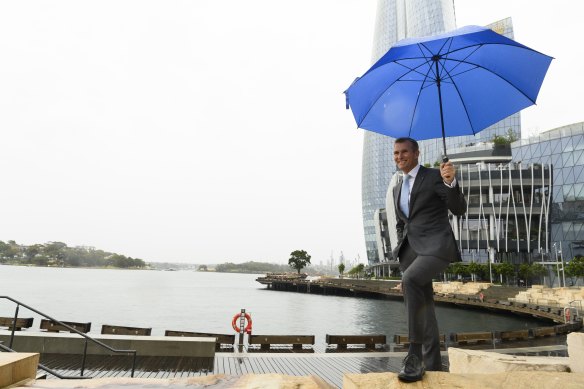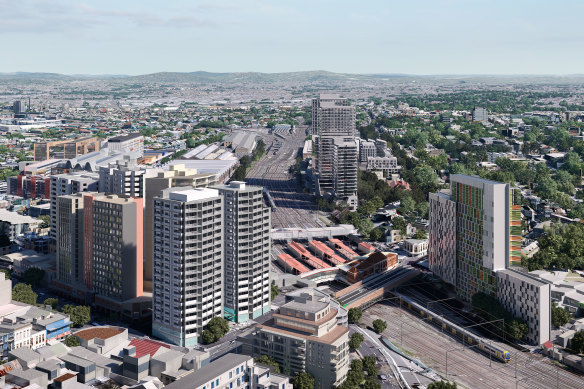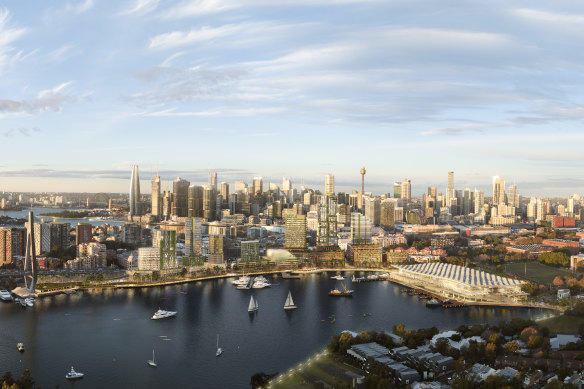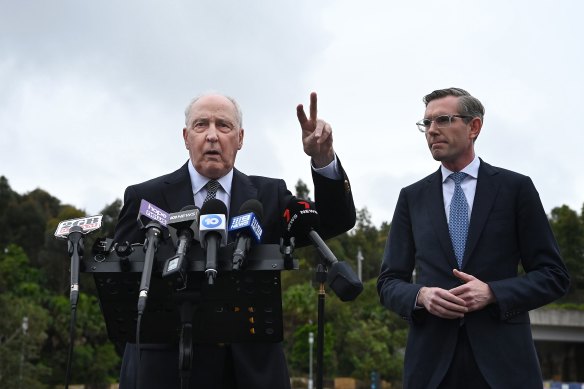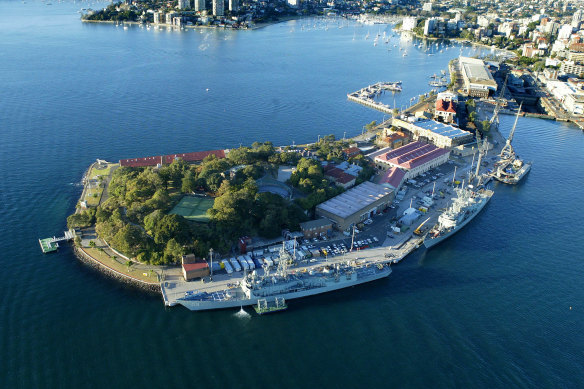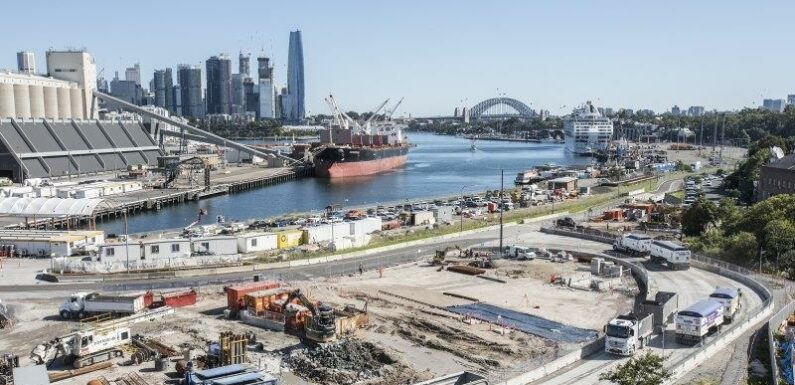
After all the argy-bargy about Barangaroo – its look, its feel, its history – one thing is clear: for many people, the process behind it has cruelled their capacity to consider it a success. Cities Minister Rob Stokes concedes the system that produced Barangaroo was “bedevilled from the start”.
“My view is we’ve borne against the process to actually get much better outcomes than might have otherwise occurred,” says Stokes, who will leave politics at the March election. “The thing we learn from that is that the process in planning really matters. If you get the process right, good decisions are easy to make; if you get the process wrong, good decisions are hard to make.”
The Barangaroo Reserve headland park, along with White Bay, are Sydney’s next huge urban renewal project.Credit:Oscar Colman
That lesson has been learnt the hard way at Barangaroo. Ten years since the sod was turned, its chequered past of unsolicited proposals, backroom deals and development creep has coloured Sydney’s view of this 22-hectare waterfront precinct.
The Herald has spent the past week reviewing the Barangaroo project; its successes, shortcomings and unresolved issues. One of the largest urban renewal schemes in Sydney’s history – and a rare opportunity to remodel part of the harbour foreshore – it was always going to be divisive.
The challenge for Sydney and NSW now is to learn the lessons of Barangaroo and apply them to the city’s forthcoming urban renewal projects – the biggest of which is right across the harbour in the area now known as Bays West.
Nearby, there is also the relocation of Sydney Fish Market, currently under way, and redevelopment of the old fish-market site into a high-density residential precinct. After a backlash from residents, Greens MP Jamie Parker and the City of Sydney, the buildings were cut back to 35 storeys.
For Cameron Logan, Barangaroo exposes the “original sin” of public planning: asset recycling. An urban and architectural historian at the University of Sydney, Logan says NSW state governments became too hooked on selling off public land and using the proceeds to fund public infrastructure.
“You’re like a private actor in the real estate game once you start with that premise,” Logan says. “You’re looking to maximise value in the financial sense, rather than acting as the steward for the state and the city with a sense of generational equity and how to manage that site for the people of NSW for the next 50 years.”
Premier Dominic Perrottet might have learnt Logan’s lesson. Asked this week by the Herald about Bays West, which is three-and-a-half times the size of Barangaroo, Perrottet said he was completely focused on putting public space ahead of developers’ interests.
“That may come at a greater cost to NSW. But the ultimate benefit for our people for generations to come should be first and foremost in our minds,” he said. “I don’t want, in 100 years, people to look back and say the Perrottet government made these decisions that put developers before people.”
The largely industrial Bays West precinct, which is 3.5 times the size of Barangaroo, is the next major urban renewal project to reshape Sydney Harbour.Credit:Steven Siewert
The government is forging ahead with plans to rezone part of Bays West – the industrial harbour front along Rozelle Bay and White Bay – to allow for the construction of apartments, offices, cultural venues and public spaces. The overhaul of the 77-hectare precinct will transform sites including Glebe Island, White Bay Power Station and the Rozelle Rail Yards in coming decades.
The government is also remaking large swathes of publicly owned land in the inner city, including around Central Station and the Waterloo public housing estate.
Stokes said the government had already taken a different approach to aspects of planning for the area around White Bay Power Station, the first of 10 Bays West “sub-precincts” that will be revamped. Stokes said the Bays Metro Station – due for completion in 2030 – would open in the early stages of the project, as would a creative hub within the power station building.
“We really pushed for [wider foreshore promenades at Barangaroo] and that has worked, so we’re going to have the same approach in relation to Bays West, so it’s centred around generous public parkland,” he said. “Also, we’re baking in the affordable and diverse housing requirements from the very beginning.”
A persistent criticism of Barangaroo is that, aside from the headland park, it lacks public benefit for ordinary people without lots of money to blow at a casino or expensive restaurants. Tied up in that is a relatively small contribution to affordable housing; 2.3 per cent at the south end of the project.
Lord Mayor Clover Moore says it’s an unforgivable shortcoming that must not be repeated. “If you can’t build public housing on public land in the city, where are you going to be able to do it?” she asked. “Access to the foreshore should be a right for everyone, not just rich people.”
Moore’s ally, the architect and former councillor Philip Thalis, concurs. “You would have thought on public land there’d be a cast-iron commitment to a certain percentage [of affordable housing]. You’ll never get the percentages [required] unless you use the public land far more proactively than it has been used.”
“Access to the foreshore should be a right for everyone, not just rich people,” Lord Mayor Clover Moore says.Credit:Wolter Peeters
Rob Stokes is also in fierce agreement. “To have a playful city, you need all the urban services workers that provide those opportunities, and they need to live somewhere near where those services are provided if you want a 24/seven economy,” he says. “You need that opportunity for affordable housing for those key workers. The provision for affordable housing [at Barangaroo] didn’t address that need.”
But early planning for Bays West hasn’t yet made any clear commitment to the amount of affordable housing at the site. The master plan for Stage 1 of the project – the White Bay Power Station precinct – proposes about 250 residential homes, but “the proportion of affordable housing has not yet been defined”, according to government documents.
Rob Stokes pushed for wider foreshore promenades and more public space at Barangaroo.Credit:Rhett Wyman
Another large state significant project is under way between Central Station and Eveleigh. At one end is the Central Precinct: 24 hectares of land – similar to Barangaroo – around Sydney’s major railway hub, plans for which recently completed public exhibition.
Another 10 hectares at Redfern-North Eveleigh (around Carriageworks) will also be redeveloped – it’s a prime piece of government-owned, inner-city land that has been closed to the public for a century. The rezoning package is due to be finalised next year, but the area is slated for 450 new homes (at least 15 per cent affordable housing), 6200 new jobs and 1.25 hectares of public open space.
An artist’s impression of the redeveloped Redfern-North Eveleigh precinct.Credit:NSW government
Thalis is sceptical about what he has seen so far. “Their North Eveleigh plan, it’s very fuzzy on public space, it’s really about development quantum. Obviously, Blackwattle Bay is driven by development quantum,” he says.
“White Bay – the development is actually not as high as you would have thought … but the public plan makes an enclave rather than a part of the larger city, which would allow everyone in Rozelle and Balmain easy access down to the foreshore.”
Logan, the Sydney University historian, cautioned against treating the industrial heritage features around the western harbour – such as the power station – as commercial assets and recycling them too quickly, saying that would likely lead to poor outcomes.
He pointed to the divisive overhaul of London’s Battersea Power Station, which has recently been transformed into a mixed-use precinct with offices, shops, restaurants and fancy apartments.
The revised proposal for the 12-building Blackwattle Bay redevelopment cuts the gross floor area by 15 per cent from the original plan.Credit:Infrastructure NSW
“You have a memory or an evocation of the power station, but it is principally a luxury real estate development,” Logan said. “The question is, is that what the [Sydney] harbour’s edge is for in its entirety? How do we do some things more quickly to provide immediate benefit, and some things more slowly?”
Logan said the cluster of finger wharves at Walsh Bay, for example, had evolved over decades into a “pretty amazing” asset for Sydney.
“The area contains quite a bit of high-priced housing; it also contains terrific facilities for a series of arts companies that might not otherwise have existed if you had done it according to a pure, ‘maximise the benefit’-type logic, and hadn’t thought about what might be a good use for these buildings, and how might we allow the new functions to follow the existing wharves.”
That said, Logan acknowledged it was “undeniable” [Barangaroo]’s been successful as a piece of commercial development and an extension of the CBD.
Former prime minister Paul Keating with Premier Dominic Perrottet this week, making an announcement about Central Barangaroo.Credit:Kate Geraghty
He said there tended to be a “respectable middle-class view that often argues not for commercial leisure but for other forms of passive and aesthetic recreation”.
“You can knock it, but you can’t also deny to some extent that there’s a certain division between politics and place making according to designers and architects, and what the public turns up to do.”
University of Sydney associate professor of urbanism Dallas Rogers said creating great public places required transparency and more investment from government. In other words, governments need to be prepared to pay, and not outsource.
“We can’t achieve the public benefit that we should expect from these sites purely from the private sector. Their development models aren’t here for producing the types of open spaces, parklands and water frontage that Sydney of the future needs.
Garden Island – could it be “the next big one”?Credit:Robert Pearce
“With these high-value urban sites that come around once in 100 years, you need to put the public interest at the centre of these projects. I think that’s the biggest legacy that will reverberate from Barangaroo around the city.”
Former prime minister Paul Keating, an influential player in the Barangaroo project both behind the scenes and in the public eye, is unimpressed by the “appallingly ordinary” plans for Bays West so far.
“That’s the next big one – and finally, if the navy ever leave Garden Island, the really big one would be Garden Island itself,” he told the Herald in an interview for this series.
“The thing that’s hardest to keep is belief in consistency. Because [you get] changing governments, changing premiers, changing treasurers, changing planning ministers and changing public officers.
“To keep a consistent creative enterprise like this going is particularly hard to do. You’ve really got to have a champion, and this is why I think for our most valuable asset – which is the harbour itself – we do need basically a guardian, we do need an authority to protect it. ”
Might Keating involve himself in the redevelopment of Bays West in the same way he made Barangaroo his post-prime-ministerial legacy? “No, no, no,” he says staunchly. “If you had three lives, I might think about it.”
The Morning Edition newsletter is our guide to the day’s most important and interesting stories, analysis and insights. Sign up here.
Most Viewed in National
From our partners
Source: Read Full Article
